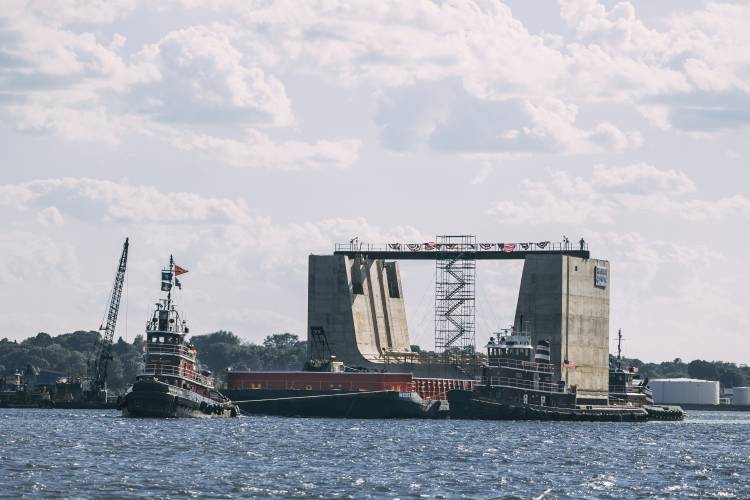From AP: A $158 million project that’s part of the Navy’s plan to make Portsmouth Naval Shipyard more efficient and less dependent on tides took a big step forward Monday with the arrival of a key component.
The 5,000-ton precast concrete entrance for one of the shipyard’s dry docks will be installed over the next four weeks, a shipyard spokesperson said. Built by Maine-based Cianbro, it arrived by barge on Monday.
It’s a key part of the “Superflood Basin” project that will allow submarines to enter Dry Dock No. 1 without a buoyancy assist system.
“The arrival of the entrance structure gets us one step closer to operating independent of the Piscataqua River tides and optimizes our dry dock operations for years of safer and more efficient use,” Capt. Daniel Ettlich, the shipyard’s commander, said in a statement.
It’s part of a $21 billion effort to upgrade the nation’s four public shipyards, each of them more than a century old, to speed maintenance and repairs at a time when the Navy is facing growing threats from China and Russia.
A congressional watchdog has warned that the aging public shipyards are failing to fully meet the military’s needs. Upgrades are underway at all four: Norfolk Naval Shipyard in Virginia, Puget Sound Naval Shipyard in Washington and Pearl Harbor Naval Shipyard in Hawaii, in addition to Portsmouth Naval Shipyard, in Kittery, Maine.
The 221-year-old Portsmouth Naval Shipyard is the nation’s oldest continuously operated public shipyard. The shipyard is tasked with repairing and overhauling nuclear-powered submarines for the Navy.
The Superflood Basin that involves Dry Dock No. 1 is one of the biggest improvements at the shipyard. That dry dock is the shallowest of three dry docks at the shipyard on Seavey Island.
In the past, Los Angeles-class attack submarines needed buoyancy cans that provided an extra 7 feet to 8 feet of clearance to safely enter that dry dock, and the newest Virginia-class attack submarines couldn’t use it at all because they’re not compatible with the system, said Danna Eddy, a shipyard spokesperson.
Similar to a navigational lock, the basin will allow the seawater level to be raised and lowered, enabling the Navy’s nuclear-powered submarines to enter the dry dock regardless of the tide.
Once completed, both classes of submarines will be able to enter the dry dock without tidal restrictions or help from buoyancy cans, Eddy said.


 Return to the Concord Monitor
Return to the Concord Monitor